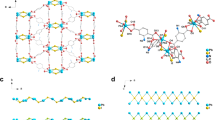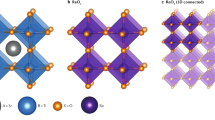Abstract
Oxynitrides have been explored extensively in the past decade because of their interesting properties, such as visible-light absorption, photocatalytic activity and high dielectric permittivity. Their synthesis typically requires high-temperature NH3 treatment (800–1,300 °C) of precursors, such as oxides, but the highly reducing conditions and the low mobility of N3− species in the lattice place significant constraints on the composition and structure—and hence the properties—of the resulting oxynitrides. Here we show a topochemical route that enables the preparation of an oxynitride at low temperatures (<500 °C), using a perovskite oxyhydride as a host. The lability of H− in BaTiO3−xHx (x ≤ 0.6) allows H−/N3− exchange to occur, and yields a room-temperature ferroelectric BaTiO3−xN2x/3. This anion exchange is accompanied by a metal-to-insulator crossover via mixed O–H–N intermediates. These findings suggest that this ‘labile hydride’ strategy can be used to explore various oxynitrides, and perhaps other mixed anionic compounds.
This is a preview of subscription content, access via your institution
Access options
Subscribe to this journal
Receive 12 print issues and online access
$259.00 per year
only $21.58 per issue
Buy this article
- Purchase on Springer Link
- Instant access to full article PDF
Prices may be subject to local taxes which are calculated during checkout





Similar content being viewed by others
References
Asahi, R., Morikawa, T., Ohwaki, T., Aoki, K. & Taga, Y. Visible-light photocatalysis in nitrogen-doped titanium oxides. Science 293, 269–271 (2001).
Maeda, K. et al. Photocatalyst releasing hydrogen from water. Nature 440, 295 (2006).
Jansen, M. & Letschert, H. P. Inorganic yellow–red pigments without toxic metals. Nature 404, 980–982 (2000).
Kim, Y. I., Woodward, P. M., Baba-Kishi, K. Z. & Tai, C. W. Characterization of the structural, optical, and dielectric properties of oxynitride perovskites AMO2N (A = Ba, Sr, Ca; M = Ta, Nb). Chem. Mater. 16, 1267–1276 (2004).
Kim, Y. I. et al. Epitaxial thin-film deposition and dielectric properties of the perovskite oxynitride BaTaO2N. Chem. Mater. 19, 618–623 (2007).
Page, K. et al. Local atomic ordering in BaTaO2N studied by neutron pair distribution function analysis and density functional theory. Chem. Mater. 19, 4037–4042 (2007).
Oka, D. et al. Possible ferroelectricity in perovskite oxynitride SrTaO2N epitaxial thin films. Sci. Rep. 4, 4987 (2014).
Jorge, A. B. et al. Large coupled magnetoresponses in EuNbO2N. J. Am. Chem. Soc. 130, 12572–12573 (2008).
Ebbinghaus, S. G. et al. Perovskite-related oxynitrides—recent developments in synthesis, characterisation and investigations of physical properties. Prog. Solid State Chem. 37, 173–205 (2009).
Fuertes, A. Chemistry and applications of oxynitride perovskites. J. Mater. Chem. 22, 3293–3299 (2012).
Gomathi, A., Reshma, S. & Rao, C. N. R. A simple urea-based route to ternary metal oxynitride nanoparticles. J. Solid. State Chem. 182, 72–76 (2009).
Watanabe, T., Tajima, K., Li, J. W., Matsushita, N. & Yoshimura, M. Low-temperature ammonothermal synthesis of LaTaON2 . Chem. Lett. 40, 1101–1102 (2011).
Clarke, S. J., Guinot, B. P., Michie, C. W., Calmont, M. J. C. & Rosseinsky, M. J. Oxynitride perovskites: synthesis and structure of LaZrO2N, NdTiO2N, and LaTiO2N and comparison with oxide perovskites. Chem. Mater. 14, 288–294 (2002).
Tessier, F. & Marchand, R. Ternary and higher order rare-earth nitride materials: synthesis and characterization of ionic–covalent oxynitride powders. J. Solid State Chem. 171, 143–151 (2003).
McAuley, A. & Hague, D. N. Inorganic Reaction Mechanisms (RSC Publishing, 1977).
Kobayashi, Y. et al. An oxyhydride of BaTiO3 exhibiting hydride exchange and electronic conductivity. Nature Mater. 11, 507–511 (2012).
Bräuniger, T., Müller, T., Pampel, A. & Abicht, H. Study of oxygen−nitrogen replacement in BaTiO3 by 14N solid-state nuclear magnetic resonance. Chem. Mater. 17, 4114–4117 (2005).
David, A. et al. High-throughput synthesis and characterization of (BaxSr1−x)1+yTi1−yO3−δ and (BaxSr1−x)1+yTi1−yO3−zNz perovskite thin films. Cryst. Growth Des. 14, 523–532 (2014).
Motohashi, T., Ito, M., Masubuchi, Y., Wakeshima, M. & Kikkawa, S. Crystal structure and superconducting properties of hexagonal lithium–niobium oxynitride. Inorg. Chem. 51, 11184–11189 (2012).
Suzuki, A. et al. High-mobility electron conduction in oxynitride: anatase TaON. Chem. Mater. 26, 976–981 (2013).
Yajima, T. et al. Epitaxial thin films of ATiO3–xHx (A= Ba, Sr, Ca) with metallic conductivity. J. Am. Chem. Soc. 134, 8782–8785 (2012).
Yang, M. et al. Anion order in perovskite oxynitrides. Nature Chem. 3, 47–52 (2011).
Yashima, M. et al. Size effect on the crystal structure of barium titanate nanoparticles. J. Appl. Phys. 98, 014313 (2005).
Lei, S. et al. Reply to “Comment on ‘Origin of piezoelectric response under a biased scanning probe microscopy tip across a 180° ferroelectric domain wall’”. Phys. Rev. B 89, 226102 (2014).
Sakaguchi, T. et al. Oxyhydrides of (Ca,Sr,Ba)TiO3 perovskite solid solutions. Inorg. Chem. 51, 11371–11376 (2012).
Hayward, M. A. et al. The hydride anion in an extended transition metal oxide array: LaSrCoO3H0.7 . Science 295, 1882–1884 (2002).
Romero, F. D. et al. Strontium vanadium oxide–hydrides: ‘square-planar’ two-electron phases. Angew. Chem. Int. Ed. 53, 7556–7559 (2014).
Bang, J. et al. Hydrogen ordering and new polymorph of layered perovskite oxyhydrides: Sr2VO4−xHx . J. Am. Chem. Soc. 136, 7221–7224 (2014).
Tassel, C. et al. Direct synthesis of chromium perovskite oxyhydride with a high magnetic transition temperature. Angew. Chem. Int. Ed. 126, 10545–10548 (2014).
Iimura, S. et al. Two-dome structure in electron-doped iron arsenide superconductors. Nature Commun. 3, 943 (2012).
Izumi, F. & Momma, K. Three-dimensional visualization in powder diffraction. Solid State Phenom. 130, 15–20 (2007).
Jungk, T., Hoffmann, A. & Soergel, E. Quantitative analysis of ferroelectric domain imaging with piezoresponse force microscopy. Appl. Phys. Lett. 89, 163507 (2006).
Lei, S. et al. Origin of piezoelectric response under a biased scanning probe microscopy tip across a 180° ferroelectric domain wall. Phys. Rev. B 86, 134115 (2012).
Acknowledgements
This work is supported by FIRST and CREST programmes of the Japan Science and Technology Agency. H.A., S.L. and V.G. acknowledge support from the National Science Foundation grant numbers DMR-1420620 and DMR-1210588. H.A. acknowledges support from Japan Society for the Promotion of Science for Research Abroad (No. 25-185). The synchrotron radiation experiments were performed at the BL02B2 of SPring-8 with the approval of the JASRI.
Author information
Authors and Affiliations
Contributions
T. Yajima and F.T. contributed equally. T. Yajima, F.T. and H.K. conceived and designed the study. F.T., K.A., M.O., W.Y. and T. Yajima performed the synthesis, laboratory PXRD, synchrotron PXRD, XPS and elemental analysis. T.Yam., C.M.B., M.A.G. and H.K. obtained the neutron data. The structural refinement was performed by K.A., T. Yamamoto and T. Yajima. W.Y. and T. Yajima fabricated the thin films. H.A., K.F., S.L., V.G. and K.T. conducted the SHG and PFM measurements and FEM simulations. All authors discussed the results. F.T. and H.K. wrote the manuscript, with contributions and feedback from all the authors, mainly T. Yajima, Y.K., H.A. and K.F.
Corresponding author
Ethics declarations
Competing interests
The authors declare no competing financial interests.
Supplementary information
Supplementary information
Supplementary information (PDF 1165 kb)
Rights and permissions
About this article
Cite this article
Yajima, T., Takeiri, F., Aidzu, K. et al. A labile hydride strategy for the synthesis of heavily nitridized BaTiO3. Nature Chem 7, 1017–1023 (2015). https://doi.org/10.1038/nchem.2370
Received:
Accepted:
Published:
Issue Date:
DOI: https://doi.org/10.1038/nchem.2370
This article is cited by
-
Anionic Defects Enhanced Ammonia Synthesis Over Ru Catalyst Supported on Barium Niobate Reduced with CaH2
Catalysis Letters (2024)
-
Critical role of hydrogen for superconductivity in nickelates
Nature (2023)
-
Anion redox as a means to derive layered manganese oxychalcogenides with exotic intergrowth structures
Nature Communications (2023)
-
The electronic properties of SrTiO3-δ with oxygen vacancies or substitutions
Scientific Reports (2021)
-
Strain-induced creation and switching of anion vacancy layers in perovskite oxynitrides
Nature Communications (2020)



